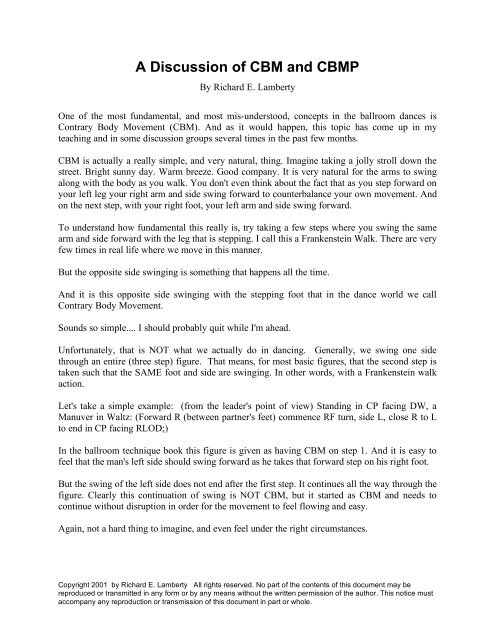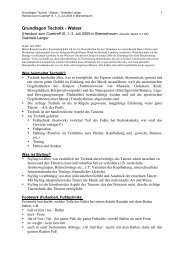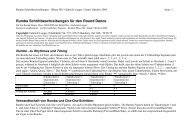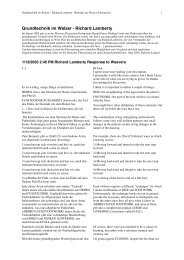A Discussion of CBM and CBMP
A Discussion of CBM and CBMP
A Discussion of CBM and CBMP
Create successful ePaper yourself
Turn your PDF publications into a flip-book with our unique Google optimized e-Paper software.
A <strong>Discussion</strong> <strong>of</strong> <strong>CBM</strong> <strong>and</strong> <strong>CBM</strong>P<br />
By Richard E. Lamberty<br />
One <strong>of</strong> the most fundamental, <strong>and</strong> most mis-understood, concepts in the ballroom dances is<br />
Contrary Body Movement (<strong>CBM</strong>). And as it would happen, this topic has come up in my<br />
teaching <strong>and</strong> in some discussion groups several times in the past few months.<br />
<strong>CBM</strong> is actually a really simple, <strong>and</strong> very natural, thing. Imagine taking a jolly stroll down the<br />
street. Bright sunny day. Warm breeze. Good company. It is very natural for the arms to swing<br />
along with the body as you walk. You don't even think about the fact that as you step forward on<br />
your left leg your right arm <strong>and</strong> side swing forward to counterbalance your own movement. And<br />
on the next step, with your right foot, your left arm <strong>and</strong> side swing forward.<br />
To underst<strong>and</strong> how fundamental this really is, try taking a few steps where you swing the same<br />
arm <strong>and</strong> side forward with the leg that is stepping. I call this a Frankenstein Walk. There are very<br />
few times in real life where we move in this manner.<br />
But the opposite side swinging is something that happens all the time.<br />
And it is this opposite side swinging with the stepping foot that in the dance world we call<br />
Contrary Body Movement.<br />
Sounds so simple.... I should probably quit while I'm ahead.<br />
Unfortunately, that is NOT what we actually do in dancing. Generally, we swing one side<br />
through an entire (three step) figure. That means, for most basic figures, that the second step is<br />
taken such that the SAME foot <strong>and</strong> side are swinging. In other words, with a Frankenstein walk<br />
action.<br />
Let's take a simple example: (from the leader's point <strong>of</strong> view) St<strong>and</strong>ing in CP facing DW, a<br />
Manuver in Waltz: (Forward R (between partner's feet) commence RF turn, side L, close R to L<br />
to end in CP facing RLOD;)<br />
In the ballroom technique book this figure is given as having <strong>CBM</strong> on step 1. And it is easy to<br />
feel that the man's left side should swing forward as he takes that forward step on his right foot.<br />
But the swing <strong>of</strong> the left side does not end after the first step. It continues all the way through the<br />
figure. Clearly this continuation <strong>of</strong> swing is NOT <strong>CBM</strong>, but it started as <strong>CBM</strong> <strong>and</strong> needs to<br />
continue without disruption in order for the movement to feel flowing <strong>and</strong> easy.<br />
Again, not a hard thing to imagine, <strong>and</strong> even feel under the right circumstances.<br />
Copyright 2001 by Richard E. Lamberty All rights reserved. No part <strong>of</strong> the contents <strong>of</strong> this document may be<br />
reproduced or transmitted in any form or by any means without the written permission <strong>of</strong> the author. This notice must<br />
accompany any reproduction or transmission <strong>of</strong> this document in part or whole.
A <strong>Discussion</strong> <strong>of</strong> <strong>CBM</strong> <strong>and</strong> <strong>CBM</strong>P By Richard E. Lamberty Page 2 <strong>of</strong> 5<br />
The problems start to arise when we 'manufacture' this contrary body movement instead <strong>of</strong><br />
allowing it to occur as a natural consequence <strong>of</strong> our movement.<br />
The most common problem is the force <strong>of</strong> the swinging side causing the moving foot to go <strong>of</strong>f<br />
track. Rather than being a true forward (or backward) step, the foot either drifts in the direction<br />
<strong>of</strong> the swing, or worse (<strong>and</strong> more commonly) moves opposite to the swing causing the stepping<br />
leg to cut across the center line <strong>of</strong> the body. The feeling is one <strong>of</strong> being twisted up.<br />
CMB should never cause the stepping foot to go <strong>of</strong>f its path. Never.<br />
Again, take a few strolling steps <strong>and</strong> see if your natural <strong>CBM</strong> causes your feet to flail around<br />
making you walk like a drunken sailor (no <strong>of</strong>fense to our men <strong>and</strong> women in the Navy.) And<br />
then force that swinging action <strong>and</strong> feel the reaction <strong>of</strong> your legs as you walk. Flail is not such a<br />
bad word.<br />
<strong>CBM</strong> in our dancing should not cause this flailing effect. The legs should always have a clear<br />
path <strong>of</strong> movement.<br />
Another problem with <strong>CBM</strong> is WHEN it occurs. When we just walk, a nice gentle <strong>CBM</strong> occurs<br />
naturally as the step is taken. In our dancing we must apply <strong>CBM</strong> when it will aid the overall<br />
movement <strong>of</strong> the figure.<br />
For reverse (left) turning actions, <strong>CBM</strong> should generally be applied AFTER the initiating step<br />
has been taken. First direct the step, then swing the opposite side as a continuation <strong>of</strong> the directed<br />
forward (or backward) movement. And by releasing that swinging side fully, you can easily<br />
generate the second step <strong>of</strong> the figure with a natural flowing feeling.<br />
For natural (right) turning actions, <strong>CBM</strong> should generally be initiated BEFORE the initiating<br />
step has been taken. The feeling <strong>of</strong> <strong>CBM</strong> will increase as the first step <strong>of</strong> the figure is taken. And<br />
the continuation <strong>of</strong> the swing <strong>of</strong> that side will enhance the second step <strong>of</strong> the figure.<br />
WARNING WILL ROBINSON! DANGER! DANGER! DANGER! It is very easy to allow this<br />
early swinging <strong>of</strong> the side to cause the stepping foot to go <strong>of</strong>f track. Great care must be taken to<br />
ensure that the initiating step remains clearly directed.<br />
Now, the obvious question to raise is why this difference between natural <strong>and</strong> reverse turns? And<br />
the obvious answer PHYSICS. The partner st<strong>and</strong>s on the right side, not directly in front <strong>of</strong> you.<br />
Your hips align to partners hips in a particular way. That alignment makes the left side feel more<br />
open than the right side.<br />
If you applied <strong>CBM</strong> early when stepping forward into a reverse turning action, you are<br />
essentially directing partner into your own path, thus cutting <strong>of</strong>f movement. In natural turns,<br />
partner is already partially blocking your path. By applying <strong>CBM</strong> early you help to clear the path<br />
so that a freer step is possible.<br />
Copyright 2001 by Richerd E. Lamberty. All rights reserved. Charging a fee for the reproduction, distribution or<br />
publication <strong>of</strong> this document, in part or whole, is strictly prohibited. This document may be copied or reproduced for<br />
private use. This notice must accompany any reproduction or transmission <strong>of</strong> this document in part or whole.
A <strong>Discussion</strong> <strong>of</strong> <strong>CBM</strong> <strong>and</strong> <strong>CBM</strong>P By Richard E. Lamberty Page 3 <strong>of</strong> 5<br />
Once you start having a clear feeling <strong>of</strong> <strong>CBM</strong> in your dancing, a new problem can arise. Like so<br />
many things in life, we might decide that if a little is good, then a lot must be better. And like an<br />
awful lot <strong>of</strong> the really fun things in life, a little IS good, <strong>and</strong> a lot, simply too much.<br />
Remember, <strong>CBM</strong> is a naturally occurring phenomenon. Manufacturing it throws <strong>of</strong>f the natural<br />
balance.<br />
Rules. Rules. Rules. Do this. Don't do that. Early here. Late there.<br />
I guess you could say that it is all true, <strong>and</strong> all false. It is possible to dance with no <strong>CBM</strong> at all.<br />
And it is equally possible to dance with all the <strong>CBM</strong> your body can generate. Late <strong>CBM</strong> on<br />
reverse turns. Early on natural turns. Of course there are exceptions. But generalities help us to<br />
think about <strong>and</strong> underst<strong>and</strong> the concepts.<br />
Now, there is that thing called <strong>CBM</strong>P. Contrary Body Movement Position. Sometimes we are<br />
already in a position where the opposite side <strong>of</strong> the body is turned towards the leg. It happens in<br />
Semi Closed <strong>and</strong> Reverse Semi Closed Positions. It happens in Contra-Banjo <strong>and</strong> Contra-Sidecar<br />
positions.<br />
In fact, it happens in any dance position which is not Closed Position. (Before you ask, we are<br />
only dealing with positions where our partner is in our arms, <strong>and</strong> only with the International<br />
St<strong>and</strong>ard Style <strong>of</strong> ballroom.)<br />
In the International St<strong>and</strong>ard system <strong>of</strong> Ballroom Dancing there are a limited number <strong>of</strong> positions<br />
which are used in the execution <strong>of</strong> all <strong>of</strong> the figures in the syllabus. The positions are:<br />
1. Closed Position<br />
2. Promenade Position<br />
3. Outside Partner<br />
4. Left Outside Partner<br />
5. Counter Promenade Position<br />
Fallaway Position is <strong>of</strong>ten mentioned in the literature, but Fallaway is defined as moving<br />
backwards in a Promenade Position. It is not actually different in any way from a Promenade<br />
Position. Only the direction <strong>of</strong> movement differs. In our discussions <strong>of</strong> technique, we will<br />
consider Fallaway the act <strong>of</strong> moving backwards in a Promenade Position rather than as a separate<br />
position.<br />
In addition to the five fundamental dance positions, we also encounter two additional<br />
fundamental positions which create our relationship to partner. These are:<br />
6. Closed Position while on Inside <strong>of</strong> Turn<br />
7. Closed Position while on Outside <strong>of</strong> Turn<br />
Copyright 2001 by Richerd E. Lamberty. All rights reserved. Charging a fee for the reproduction, distribution or<br />
publication <strong>of</strong> this document, in part or whole, is strictly prohibited. This document may be copied or reproduced for<br />
private use. This notice must accompany any reproduction or transmission <strong>of</strong> this document in part or whole.
A <strong>Discussion</strong> <strong>of</strong> <strong>CBM</strong> <strong>and</strong> <strong>CBM</strong>P By Richard E. Lamberty Page 4 <strong>of</strong> 5<br />
All seven <strong>of</strong> the possible dance positions, or relationships to partner, are given by FIVE possible<br />
foot positions. Those five foot positions are:<br />
1. Both feet pointed directly forward, neither turned away from nor in towards your own<br />
center<br />
2. Both feet pointed away from your own center<br />
3. Both feet pointed towards your own center<br />
4. Left foot pointed away from your own center, right foot pointed towards your own center<br />
5. Left foot pointed towards your own center, right foot pointed away from your own center<br />
Sometimes a picture is worth a thous<strong>and</strong> words....<br />
In following simple diagrams, the character '^' represents the center <strong>of</strong> your body. The characters<br />
'|', '\', <strong>and</strong> '/' represent a foot <strong>and</strong> the direction it is pointing.<br />
1. |^| = Closed Position<br />
2. \^/ = Inside Of Turn<br />
3. /^\ = Outside Of Turn<br />
4. \^\ = Outside Partner (Semi Closed for Man, Reverse Semi Closed for Lady)<br />
5. /^/ = Left Outside Partner (Semi Closed for Lady, Reverse Semi Closed for Man)<br />
At any time the feet are not pointed directly forward, both feet must be pointed either away from<br />
or towards your own center (the different combinations making for the different possible<br />
positions) <strong>and</strong> must be turned in equal amounts.<br />
You would not have the left foot turned out at 45 degrees <strong>and</strong> the right foot turned either in or<br />
out any other amount that 45 degrees, for example. The actual amount <strong>of</strong> turn in or out can vary.<br />
It simply must be equal on each side <strong>of</strong> the body.<br />
Additionally, the amount <strong>of</strong> turn in the feet that one person makes should match the amount <strong>of</strong><br />
turn in the feet that partner makes. (If you must know, I believe (but would not bet my house on)<br />
that there is an exception to this last statement. But I'm not going to tell you what it is.)<br />
Now, why is all this important?<br />
Because <strong>of</strong> <strong>CBM</strong>P. Clearly if 6/7 <strong>of</strong> our dance positions do not have the feet pointed directly<br />
forward then a lot <strong>of</strong> our dancing is occurring in other than simple Closed Position.<br />
Actually, Inside <strong>of</strong> turn <strong>and</strong> Outside Of Turn are really both variants <strong>of</strong> Closed Position. And<br />
when one person is st<strong>and</strong>ing in Inside Of Turn, the other must be st<strong>and</strong>ing in Outside Of Turn.<br />
(No exceptions.)<br />
Copyright 2001 by Richerd E. Lamberty. All rights reserved. Charging a fee for the reproduction, distribution or<br />
publication <strong>of</strong> this document, in part or whole, is strictly prohibited. This document may be copied or reproduced for<br />
private use. This notice must accompany any reproduction or transmission <strong>of</strong> this document in part or whole.
A <strong>Discussion</strong> <strong>of</strong> <strong>CBM</strong> <strong>and</strong> <strong>CBM</strong>P By Richard E. Lamberty Page 5 <strong>of</strong> 5<br />
But that still leaves us with 4/7 <strong>of</strong> the positions having the feet turned in relationship to our own<br />
centers. And surprise, surprise, surprise. That is what Contrary Body Movement Position is.<br />
St<strong>and</strong>ing with the opposite side <strong>of</strong> the body turned towards the leg.<br />
If you are st<strong>and</strong>ing with your feet in position 4 as listed above with the weight on your left foot,<br />
<strong>and</strong> step forward with your right foot, you will be stepping in Contrary Body Movement Position<br />
(<strong>CBM</strong>P.)<br />
Likewise st<strong>and</strong>ing on your right foot <strong>and</strong> stepping backwards on your left foot, that step is in<br />
<strong>CBM</strong>P.<br />
St<strong>and</strong>ing in position 5 with weight on the left foot, <strong>and</strong> step back on the right would be in<br />
<strong>CBM</strong>P. And with weight on the right, a step forward on the left is taken in <strong>CBM</strong>P.<br />
Steps in <strong>CBM</strong>P occur all the time in our dancing. Stepping thru in Promenade or Counter<br />
Promenade Position. The second quick <strong>of</strong> any feathering action. In fact any step outside partner<br />
is taken in <strong>CBM</strong>P.<br />
Just as in dealing with Contrary Body Movement, steps taken in <strong>CBM</strong>P have a host <strong>of</strong> problems<br />
which commonly arise. The foremost <strong>of</strong> these is the temptation to step across the center line <strong>of</strong><br />
the body.<br />
At any point when you step across the center line <strong>of</strong> your own body one <strong>of</strong> two things will occur.<br />
Either you will CHECK your forward or backward movement. OR. (<strong>and</strong> here is the problem)<br />
your spine must shift sideways to accommodate that crossing action <strong>and</strong> return to a point <strong>of</strong><br />
balance which can be shared with partner.<br />
The simple rule is: the left foot belongs on the left side <strong>of</strong> the body; the right foot belongs on the<br />
right side <strong>of</strong> the body. Exceptions? Plenty. But they are all checking actions where direction <strong>of</strong><br />
movement will be halted or reversed. (Which includes lock steps.)<br />
The most important thing to remember is that the International St<strong>and</strong>ard style <strong>of</strong> Ballroom<br />
dancing, which is the primary source <strong>of</strong> all higher lever Round Dance figures, is based on a very<br />
clear, <strong>and</strong> fundamentally natural, usage <strong>of</strong> the human body. If you find yourself doing things<br />
which feel pr<strong>of</strong>oundly unnatural, then it is appropriate to question what is happening <strong>and</strong> look for<br />
a more natural feeling way to dance.<br />
<strong>CBM</strong> is a fundamentally natural thing. <strong>CBM</strong>P is also fundamentally natural given the<br />
relationship between the two partners in the couple.<br />
On the other h<strong>and</strong>, no one said it was easy…<br />
Copyright 2001 by Richerd E. Lamberty. All rights reserved. Charging a fee for the reproduction, distribution or<br />
publication <strong>of</strong> this document, in part or whole, is strictly prohibited. This document may be copied or reproduced for<br />
private use. This notice must accompany any reproduction or transmission <strong>of</strong> this document in part or whole.






